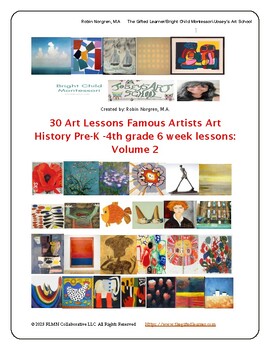30 Art Lessons Famous Artists Art History VOLUME 2 Pre-K-4th Grade
- PDF
Description
This art curriculum teaches about 30 famous artists and encourages students to create art inspired by them. This product is a wonderful way to engage your students in the creative process while also teaching them about important art movements and techniques.
By incorporating an art curriculum that features 30 famous artists into your classroom, you can help your students develop their creativity while also teaching them about important art movements and techniques. These lessons can serve as a springboard for discussions about history, culture, and self-expression.
THIS LESSON COMPLIES WITH MANY ELA COMMON CORE STANDARDS
Thirty artists:
Table of Contents
Georgia O’Keefe/Oriental Poppies…………………………………6
Claude Monet/Lillies………………………………….15
Vincent Van Gogh/Blossoming Almond Trees………..25
Roy Lichtenstein/Explosion………………….34
Alberto Giacometti/Figure Drawing……………..43
Alexander Calder/Spiral Magnitif…………53
Eric Carle/Fish……………………….64
Enrico Baj/Fire! Fire!.....................78
Wayne Thiebaud/Ice Cream Cones…………….91
Amedeo Mondigliani/Faces………………..100
Robert Motherwell/Personage…………..113
Mark Rothko/No. 1 Royal Red and Blue……..123
Clare Youngs/Lion………….132
Roger Hilton/Foliage with Orange Caterpillar……..141
Tyree Guyton/Time………………152
Michael Strouth/Chicken with Chicks………165
Edgar Degas/Marine Sunset…………..178
Mizuko Goto/Elephant……………..189
Jean Dubuffet/Hairy Dhotel …………..199
Paul Klee/Growth of the Night Plants …………211
Stuart Davis/Composition………………..221
Frank Bowling/Who’s Afraid of Red, Yellow,Blue………..231
Kazimir Malevich/Landscape with Firehouses…………..245
Arkhip Kuindzhi/Clouds………………….257
Alma Thomas/Watusi…………………….267
Alfred Wallis/Sailboats……………..278
Karel Appel/Figures………291
Agnes Martin/Buds……………….300
Betye Saar/Sun and Stars…………..308
Patrick Heron/Abstract Art…….317
Each Artists is highlighted with 3 take away facts
Art lessons range 20-45 minutes each
IN EACH LESSON:
-Copy of the original painting
-biography of the artist
-questions to ask your students to engage the painting
-FULL COLOR AND THOROUGH step by step instructions
CLICK HERE to view my freebies
CLICK HERE to view my DRAWING LESSONS
CLICK HERE to view my ART WITH THE MASTERS ART LESSONS
CLICK HERE to view my CONTEMPORARY ART LESSONS
CLICK HERE to view my ART LESSONS THAT COMPLIMENT POPULAR BOOKS
CLICK HERE to view my SELF ESTEEM PROJECTS
CLICK HERE to view my CLASS MURAL IDEAS
CLICK HERE to view my FUN ART FOLK ART LESSONS
CLICK HERE to view my 3 BUNDLED LESSONS
CLICK HERE to view my 5 BUNDLED LESSONS
Make sure to click the GREEN STAR near my store name so that you can stay in touch with my store. I create new lessons every week.





